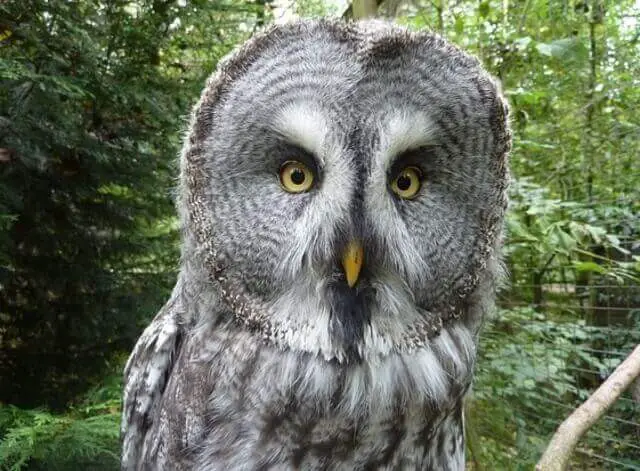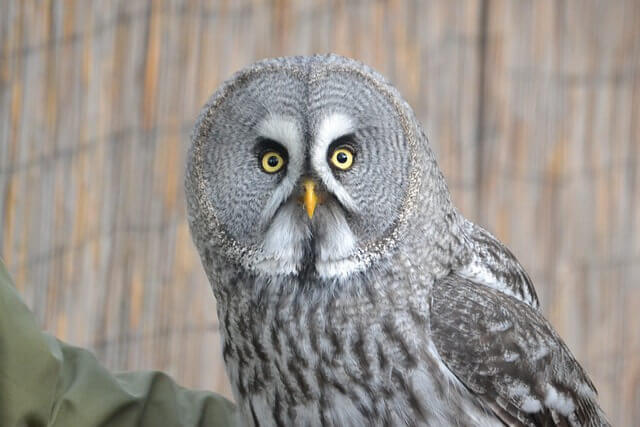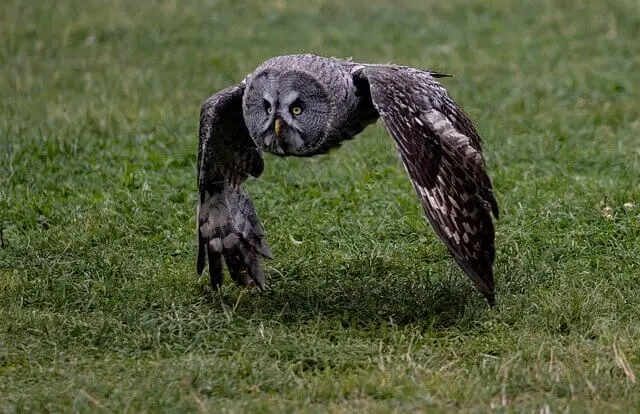The Great Gray Owl, often called the “Phantom of the North,” captivates birdwatchers and nature enthusiasts with its striking appearance and elusive nature. This majestic owl holds many intriguing secrets.
In this collection of 60 Great Gray Owl facts, we explore their unparalleled hunting skills, unique survival adaptations, and more. Join us as we uncover the fascinating details of this remarkable bird’s life and habits.
Fun Facts About Great Gray Owls
| Characteristics | Description |
|---|---|
| Identification | The Great Gray Owl is a master of camouflage with a silvery gray coat, brown barring, and streaking. It has a big round head with a facial disk outlined in grayish-brown, fading into white on the lower half. Its eyes have yellow irises with black pupils, and it has a short, downward-hooked yellow bill. |
| Adult Length | 23.6-33.5 in (60-85 cm); Females (Avg): 2.3 feet; Males (Avg): 2.2 feet. |
| Adult Weight | 1.3-4.8 lbs. (20.8-76.8 oz); Females (Avg): 2.9 lbs; Males (Avg): 2.2 lbs. |
| Wingspan | 53.9 – 60.2 in (137-153 cm); Females (Avg): 4.8 feet; Males (Avg): 4.7 feet. |
| Taxonomy | Order: Strigiformes, Family: Strigidae, Genus: Strix, Species: S. nebulosa, Binomial Name: Strix nebulosa, Scientific Name: Strix nebulosa. |
| Distribution Range | North America: Southern Canada, most of Alaska, northern New England, Minnesota to Maine in the east, Arizona to California in the west, Florida to eastern Oregon in the south. Europe: Sweden, Russia, Norway, Finland, Ukraine, Belarus, China, Kazakhstan, Lithuania, Germany, Poland. Asia: Eastern and Western Asia. |
| Habitat | Forests, mountains, prairies, woodland, open fields, mountainsides, tundra regions. |
| Diet | Small mammals (pocket gophers, hares, moles, weasels, rabbits, shrews, voles, squirrels, chipmunks) and other birds (thrushes, jays, grouse, quail, ducks, smaller hawks). |
| Lifespan | In the Wild: 13 years (starvation is the main cause of death); In Captivity: up to 40 years. |
| Population | North America: Estimated 90,000 individuals; Global: Estimated 190,000 individuals; Global Population Breeding Pairs: 25,000 pairs. |
| Conservation Status | Listed as Least Concern (Population is stable). |
| Nesting Behavior | Reuses old nests from raptors. Female lays about four eggs, incubates for 28-36 days. Young owlets hop from branch to branch at about three to four weeks, begin to fly a couple of weeks later. |
| Incubation Length | 28-35 days. |
| Nestling Length | 25 – 30 days. |
| Clutch Size | 2 – 5 eggs. |
| Number of Broods | 1 Brood. |
| Egg Description | Small and pale white. |
- Popular Among Bird Watchers: The Great Gray Owl is a favorite among bird watchers because they are relatively easy to spot during their breeding season, which occurs from March to August.
- Largest North American Owls: Great Gray Owls hold the title of being the largest owls in North America, boasting an impressive wingspan of up to five feet and a weight ranging from three to four pounds.
- Sexual Maturity: These owls reach sexual maturity at around two to three years of age. While they can start breeding as soon as they reach this age, it typically takes them another year or two to develop the strength and stamina required for courtship displays.
- Hunting Technique – Perch-and-Pounce: Great Gray Owls primarily prey on small mammals, including mice, rabbits, squirrels, and raccoons. They are known for their patient hunting technique, often remaining motionless for extended periods before executing rapid, precise attacks—a strategy known as “perch-and-pounce.”
- Natural Predators: Despite their size and ferocity, adult Great Gray Owls do have some natural predators, including the Great-horned Owl, Golden Eagle, Common Raven, Northern Goshawk, Broad-winged Hawk, Lynx, and Black Bear.
- Tallest Owl Species: Among owl species worldwide, Great Gray Owls stand out as the tallest. On average, they measure about 2 feet tall, but some individuals can reach heights of up to 3 feet.
- Courtship Leks: During the mating season, male Great Gray Owls gather in groups known as “courtship leks” to attract females through various displays and vocalizations.
- Sexual Dimorphism: The Great Gray Owl is a sexually dimorphic species, meaning that females are generally larger than males. The extent of this size difference may vary with factors such as the time of year and diet. On average, there is about a 20% weight difference between males and females, and this size difference can influence sexual dominance hierarchies.
- Migratory Bird Treaty Act: In the United States, the Great Gray Owl, along with all migratory birds, is protected by the Migratory Bird Treaty Act of 1918. This federal law prohibits hunting or killing migratory birds, as many species were facing endangerment due to hunting practices at the time of its enactment.
- Nesting Behavior: Great Gray Owls have a unique nesting behavior; they do not construct nests but instead prefer to utilize old nesting spots previously occupied by raptors. These nesting spots are typically found high in old trees with advantageous vantage points, which helps protect them from potential predators.
- First Description and Classification: The Great Gray Owl was first described by Johann Reinhold Forster in 1772, based on a specimen collected by Andrew Graham. In the same year, this owl was classified as a new species.
- Dr. John Richardson’s Discovery: Dr. John Richardson, a fur trader and explorer who lived in the Canadian wilderness, made a significant discovery on 23 May 1826. He found Canada’s first Great Gray Owl nest at Great Bear Lake, Northwest Territories, Canada. This discovery confirmed that the large gray owls in this area were indeed a new species to science, rather than an isolated population.
- Predatory Behavior: The Great Gray Owl is a formidable and fierce predator, especially when it comes to defending their nest. Their size and ferocity enable them to drive off even large predators like black bears.
- Collective Nouns: Owls have various collective nouns, including a “glaring” (a small number of owls in one place), a “bazaar” (a group that gathers at night to hunt prey together), a “parliament” (comprising two or more pairs of breeding owls), and a “wisdom” (a group with three or more members).
- Exceptional Neck Rotation: Great Gray Owls possess the remarkable ability to rotate their heads as much as 270 degrees, granting them the power to observe their surroundings in any direction. This adaptation aids in their survival in the wild, where potential predators are always present.
- Owlets’ First Flight: Young Great Gray Owls, known as owlets, take their inaugural flight between the ages of 4 and 6 weeks. During this time, they acquire the skills needed for flight and coordination. It also marks the beginning of their exploration of the environment, including hunting opportunities nearby. Young owls can remain airborne for approximately 10 minutes before needing to land.
- Sexual Maturity: Typically, the Great Gray Owl attains sexual maturity at the age of 2 or 3 years, though it may take longer for some individuals.
- Coordinated Strikes: Groups of Great Gray Owls occasionally engage in coordinated strikes against prey. They use calls to coordinate their actions with each other during these hunting efforts.
- Remarkable Longevity: The oldest recorded Great Gray Owl in the wild lived to be almost 19 years old. This longevity is a testament to the species’ thriving status in its natural habitat, considering that the average lifespan for a wild owl is approximately 13 years. Some individuals have even survived up to 40 years in captivity.
- Cold Survival Adaptation: Great Gray Owls have a unique adaptation that aids their survival in cold environments. They possess a small number of blood vessels in their ears, which help warm up the air before it enters the ear canal, helping them withstand low temperatures.
- Predatory Specialization: The Great Gray Owl is a predatory bird known for its specialization in hunting and consuming large prey. Their talons are well-adapted for tearing apart sizable prey, making them proficient hunters of adult snowshoe hares. Additionally, they have the capability to consume up to 1,500 rodents in a single year, but they will also feed on smaller mammals like rabbits and squirrels when these opportunities arise.
- Adult Weight Variation: Adult Great Gray Owls typically weigh between 2 to 3 pounds. Adult females tend to have an average weight of 3 pounds, while adult males generally weigh around 2 pounds.
- Diurnal Hunting Behavior: In contrast to many other owl species, Great Gray Owls exhibit diurnal hunting behavior. They are active hunters during daylight hours and are often observed hunting during Arctic summers when there are 24 hours of daylight. This unique behavior is due to their reliance on vision rather than camouflage to capture prey. They take advantage of extended daylight to locate and capture food without the need to fly at night or in darkness.
- Impressive Flight Speed: The Great Gray Owl can achieve remarkable speeds of up to 55 km/h (34 mph) during level flight.
- Silent and Stealthy Predators: Great Gray Owls are among the most silent, solitary, and stealthy predators in North America. They possess exceptional hearing abilities, estimated to be 10 times better than that of humans. This keen sense of hearing enables them to detect rodents moving beneath deep snow with remarkable precision. Their super-sensitive ears are capable of picking up low-frequency sounds that are beyond the range of human hearing.
- Exceptional Vision: The vision of the Great Gray Owl is extraordinarily strong, estimated to be 10 to 100 times more powerful than human vision. While the average person has 20/20 vision, allowing them to see objects clearly from 200 feet away, the Great Gray Owl’s vision enables it to discern objects at a distance of at least 2,000 feet.
- Unique Feeding Adaptation: Great Gray Owls employ their throat muscles to create a vacuum seal when swallowing food. This adaptation allows them to consume prey whole with ease.
- Feather Tufts for Warmth: One notable feature of these owls is the presence of feather tufts on their legs. These feather tufts serve to keep them warm while perched on branches in cold weather conditions.
- Cold Weather Survival Strategy: During cold winter days, Great Gray Owls remain warm by sitting on branches and fluffing their feathers to trap air within them, providing effective insulation. Unlike some animals with fat reserves for insulation, these owls rely on this unique method to stay warm when temperatures drop below freezing.
- Distinctive Facial Disk: The Great Gray Owl is characterized by its facial disk outlined in grayish-brown, which fades into white on the lower half. This distinctive feature enhances their ability to capture sound and pinpoint the location of prey.
- Selective Nest Reuse: When selecting old nesting spots previously used by raptors, Great Gray Owls demonstrate a level of selectivity. They often prefer nests that are situated in high trees with excellent vantage points, ensuring their safety from potential threats.
- Territorial Defense: Great Gray Owls are known for their territorial behavior. They defend their territories fiercely, particularly during the breeding season. Intruding owls, including other Great Gray Owls, are met with aggressive displays and vocalizations.
- Adaptation to Snowy Environments: Their plumage is well-suited for snowy environments. Their predominantly silvery-gray coloration serves as effective camouflage against snow-covered landscapes, aiding them in both hunting and avoiding predators.
- Conservation Success: Despite facing various challenges, the Great Gray Owl has managed to maintain a stable population, earning it a status of “Least Concern” on the conservation scale. This remarkable success is a testament to their adaptability and resilience in their natural habitats.





